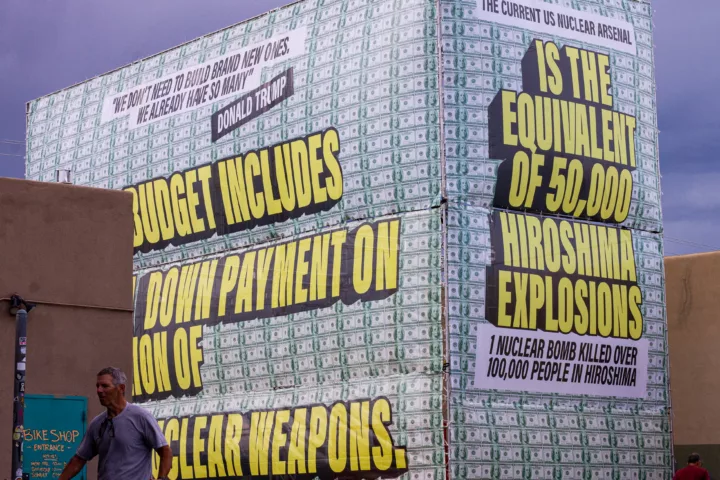From the Albuquerque Journal
New nuclear ‘pit’ production at LANL is unnecessary
By Jay Coghlan
Friday, July 21st, 2017 at 12:02am
SANTA FE, N.M. — The Center for Public Integrity recently published a series of articles on nuclear safety lapses in plutonium pit production at the Los Alamos lab that captured a lot of national attention.
Plutonium pits are the fissile cores of nuclear weapons that initiate the thermonuclear detonation of modern weapons. The articles were largely based on the National Nuclear Security Administration’s annual contractor Performance Evaluation Reports. Those reports are publicly available only because Nuclear Watch New Mexico successfully sued for them in 2012.
The former plutonium pit production site, the Rocky Flats Plant near Denver, was shut down by a 1989 FBI raid investigating environmental crimes. A special grand jury indicted both Department of Energy (DOE) officials and the contractor, but a federal judge quashed the indictments at the urging of the local federal attorney general. It was only by sheer luck that a major plutonium fire on Mother’s Day 1969 didn’t contaminate Denver with highly carcinogenic plutonium.
I specifically recall senior DOE officials promising New Mexicans 20 years ago that serious lessons were learned from Rocky Flats and that re-established plutonium pit production at the Los Alamos National Laboratory (LANL) would always be safe. Since then, the lab has spent billions of taxpayers’ money on plutonium pit production but, as the recent articles document, LANL still can’t do it safely.
As the articles reported, a serious nuclear criticality accident was narrowly averted in July 2011, which resulted in the three-year shutdown of LANL’s main plutonium facility. Nevertheless, according to the fiscal year 2011 LANL Performance Evaluation Report, the lab contractor was paid $50 million in pure profit for that year.
In 2014, a radioactive waste barrel improperly prepared by LANL ruptured underground at the Waste Isolation Pilot Plant (WIPP), shutting down that multi-billion-dollar facility for nearly three years. Radioactive waste disposal at WIPP will remain constrained for years, raising the question of where future LANL bomb-making wastes will go.
Congress has required the Los Alamos lab to quadruple plutonium pit production, regardless of the technical needs of the stockpile. The requirement was drafted by professional staff on the House Armed Services Committee, one of whom was originally from the Sandia nuclear weapons lab.
That the existing stockpile doesn’t need pit production is demonstrated by the fact that none has been scheduled since 2011 when LANL finished up the production run that was stopped when Rocky Flats was shut down.
At NukeWatch’s request, former U.S. Sen. Jeff Bingaman (D-NM) required an independent study of the lifetimes of pits. The expert conclusion was that plutonium pits last at least a century, more than double government estimates (the oldest pits in the stockpile are now around 45 years old). Moreover, there are some 20,000 existing plutonium pits stored at the Pantex Plant near Amarillo, Texas.
Future plutonium pit production is for a new so-called “Interoperable Warhead” that is supposed to function both as a land-based ICBM and a sub-launched nuclear warhead. The nuclear weapons labs are pushing this $13 billion make-work project that the Navy doesn’t want.
Ironically, new-design pits for the Interoperable Warhead may hurt national security because they cannot be tested in a full-scale nuclear weapons test or, alternatively, testing them would have severe international proliferation consequences.
Given all this, why expand plutonium pit production when apparently it can’t be done safely and may decrease, not increase, our national security? One strong reason is the huge contractor profits to be had under the $1 trillion-plus “modernization” of the nuclear weapons stockpile and production complex started under Obama, which Trump promises to expand. Far from just “modernization,” existing nuclear weapons are being given new military capabilities, despite denials at the highest levels of government.
The directors of the Livermore, Sandia and Los Alamos nuclear weapons labs in truth wear two hats – the first as lab directors, the second as presidents of the for-profit limited liability corporations running the labs. This inherent conflict of interest skews U.S. nuclear weapons policy and should be brought to an end.
The New Mexico congressional delegation kowtows to the nuclear weapons industry in our state. I specifically call upon Senators Tom Udall and Martin Heinrich to certify within this calendar year that future plutonium pit production at the Los Alamos Lab will be safe, or otherwise end their support for it.
Jay Coghlan is the director of Nuclear Watch New Mexico.
From pogo.org
